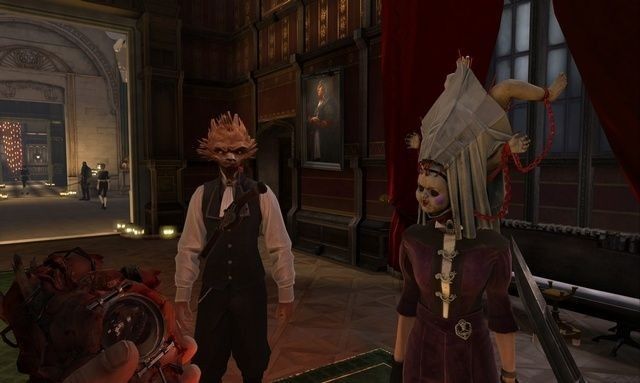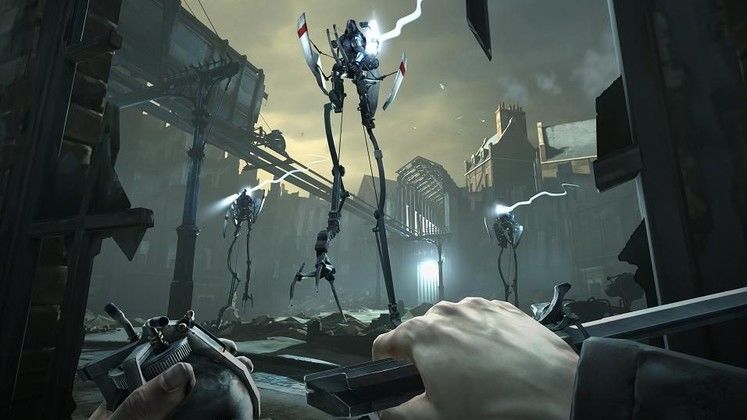I still don’t get it – but that’s just because the demo dumps you into the middle of the game, with all these baffling abilities and gadgets, and tells you to go have fun. Fumbling about the level, dying several times and awkwardly shoving people into bins, I started to get an appreciation for what people saw. At its core, Dishonored is a game about choice – without giving too much away the main plot-line involves you having to eliminate several people in a revenge-type fashion, but from what we’ve been told (which was backed up by emergent gameplay within the demo), all of the player’s main targets can be taken out in non-lethal manner. This simple and very binary choice forms the ground work for a game that’s almost a sandbox unto itself, taking the very best concepts from games like Fallout and The Elder Scrolls and applying it to this alternate steampunk universe. You’re given a goal; you’re given some tools – go nuts.
 |
| Yeah, just a little bit creepy... |
But it’s a game you can’t just stumble into and hope to do well in – as evidenced by my very awkward and disorientating hands-on session. Starting from the beginning, we imagine you’ll naturally come to realise all the game’s potential, but sitting there trying to figure out what everything did wasn’t exactly the best way to introduce someone to the game. Another example is when I overheard a demonstrator telling the guy next to me that I could possess a fish, swim under the grate, and then swap places with it in order to infiltrate this mansion from below. These kind of secret gameplay shortcuts are as bizarre as they are indicative of the amount of care that has gone into really making the game open to all possibilities, and it’s exciting to see.
Dishonored even shakes free of the binary states of good vs. evil, instead preferring to measure everything in terms of ‘Chaos’ – how much damage did you cause? How many people were killed as collateral to get to your target? How many bottles of expensive wine did you knock over? There’s also a central hub from which you go out and tackle missions, and there are also side quests and missions for you to undertake as well. I ended up in duel with some noble at a party because I handed him a note, which I assume was filled with disparaging remarks about this chap’s number. Anyway, after I beat him, I then silently dispatched his two guards just in case they got any funny ideas and turned on me, and then dumped their bodies in the shrubbery.
 |
| These things are always a pain in the butt |
In terms of actual gameplay, Corvo’s (the guy you play as) arsenal is as much (if not more) supernatural than anything else. You have some gadgets – knives, swords crossbows… a throbbing heart. The usual. But you also a number of powers that help augment your abilities in form of active, passive and then bone charms. The bone charms especially add a certain amount of replayability to the proceedings, as it’s been stated you won’t be able to find them all in a single playthrough. The powers though help you in your quest for revenge, and can range from bending time, to possession (fish everywhere, beware) to things like Blink that allow you to transport over short distances. These abilities use ‘mana’ which along with health can be replenished by using potions etc…
New IP is something the console industry sorely needs right now, so it’s reassuring to see games like Dishonored starting to appear on the market, even if it is late in the console generation. The wide range of abilities and approaches to any given situation will mean that everyone’s Corvo is, to some extent, going to be unique, as is their story. Like all stealth-action games, this is one that’ going to take some getting used to, along with a lot of trial and error and a lot of save loading (convenient then that you can save anywhere, apart from when in combat). We liked what we’ve seen so far, so definitely look forward to playing more. Dishonored is due out on PlayStation 3, Xbox 360 and PC on October 9th in North America, and October 12th in Europe.
Most Anticipated Feature: Seeing how the gameplay holds up towards the end-game. If it’s just endless amounts of “go here, kill that” then that could end up getting stale.




